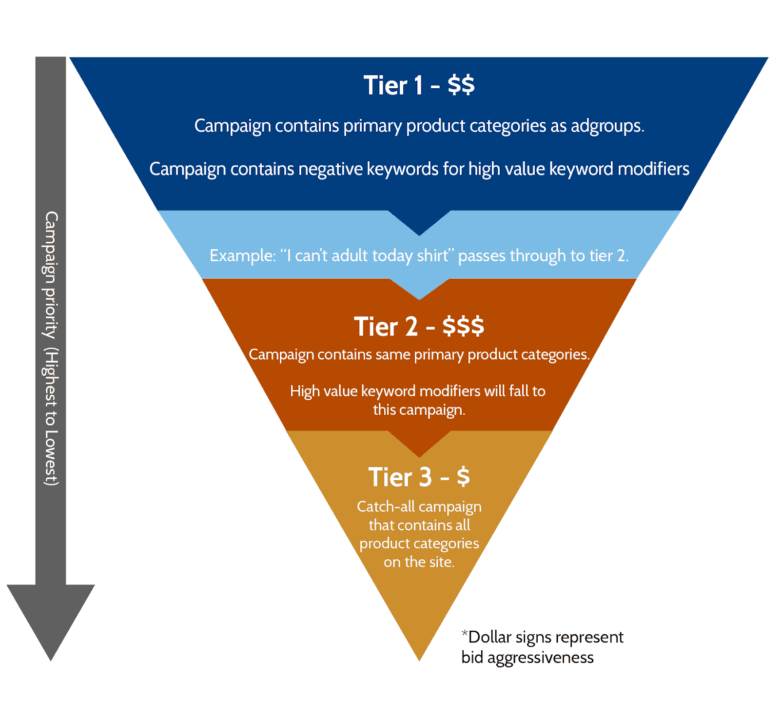Before I became the Director of Marketing at Inflow, I worked at various consumer packaged goods companies that utilized eCommerce as one of their go-to-marketing channels. A classically trained brand marketer, I was able to learn more about digital activations as a part of promoting this channel. That’s where I got my feet wet with launching PPC ad campaigns, developing SEO strategies, optimizing our websites to increase conversions, and other digital marketing tactics.

But I wanted to learn more technical and tactical digital marketing skills to complement my strategic skill set. I figured the best way to get the experience I wanted was to join a digital marketing agency.
I was a little concerned, though, as I didn’t want to choose the wrong agency. I had signed on several agencies before and, while I had some positive experiences, I also had plenty of underwhelming ones. What if I joined an agency that wasn’t great? How could I make sure the agency I joined was a leader in digital marketing?
To avoid this potential mistake, I dug into nitty-gritty details of the agencies I had worked with over the years, to see if I could distinguish what separates the good from the bad.
I eventually noticed two trends in the agencies that didn’t work out:
- The agency delivered sub-par work. Or they delivered work we could have easily done in-house.
- The agency didn’t customize its strategies for our company. Instead, they brought “turn-key” solutions from past clients that didn’t fit our goals or audience.
For me, these two trends signaling lackluster performance could be boiled down to a lack of innovation. I know innovation is an abstract term. But don’t worry – below I’m going to define how to spot innovation in agency proposals and deliverables. For now, just know that evidence of innovation became my litmus test for how to find a good agency. And it’s how I found my current role at Inflow, an eCommerce marketing agency.
Interestingly, this “innovation litmus test” is also a good filter for an eCommerce business looking to hire a digital agency because it helps you be more discerning.
In this post, I’m going to cover three examples of what innovation looks like in practice, detailing PPC, SEO, and CRO strategies from the work we’ve done at Inflow. My hope is this can serve as a guide for eCommerce companies looking to hire better agencies, whether it be us or anyone else.
First, I’m going to cover what I’m talking about when I say “innovation.” Then, I’m going to go over the questions you can ask an agency you potentially want to work with to see if they pass the innovation litmus test.
How to Spot Innovation and Pre-Engagement Questions to Ask Your Agency
As I mentioned above, the common question that can help you spot a quality agency is: does the agency innovate?
For me, the signs of an innovative marketing company were the exact opposite of the trends of bad agencies. Specifically, the kind of agencies I wanted to work with were doing two things:
#1: Delivering cutting-edge, high-quality work.
If a marketing team is turning in great work, it means they aren’t settling for what worked before or simply going through the motions. You can’t push the edge of your field without first being at the edge.
#2: Developing marketing strategies that solve a problem for the brand’s audience.
If an agency turns in marketing strategies customized to your brand and audience, that means the agency is looking at the details of your company and competition, and not relying simply on what worked for them before with past clients. Innovation thrives off the specifics of a problem. This is especially apparent when reading proposals – look for a detailed analysis of why the agency chose the strategy specifically for your situation and the nuanced details that show they understand the unique issues you and your customers face.
But if you’re not yet working with an agency, it can be difficult to gauge the value of their digital marketing services. To get around this, you need to be able to dissect their previous marketing efforts.
You can do this by analyzing past case studies to determine:
- How did the agency actually get the results?
- What process did the agency use?
- Does the agency do this for every client?
These are questions you should be asking agencies before you sign any SOWs.
- Don’t just look at the graphs presented in the case study to confirm that all the arrows are going up and all percentages have a plus sign, but dig deep into the case study for evidence of innovation.
- Do keep asking variations of the questions above until you get detailed stories of how the work happened. (For reference of how detailed their answers should get, look at our examples below.). If they can’t provide these, it means something is not right about their work quality or they simply aren’t innovating.
Example of Innovation in Pay-Per-Click Advertising: Using a Brand’s Audience to Create Strategic Facebook PPC and Google Shopping Campaigns
Retargeting strategies are a pivotal element of paid advertising campaigns. That’s the status quo for PPC, since most eCommerce websites have a low conversion rate. Since people are unlikely to convert on their first visit, you re-target to increase your conversions. Doing this as a PPC agency is not “innovation,” but rather table stakes to play the game.
At Inflow, we noticed that typical PPC campaigns consist mostly of these remarketing ads and other bottom-of-funnel ads aimed at ushering prospects towards the checkout. But we wanted to see if top-of-the-funnel prospects (which are traditionally ignored by PPC campaigns because they may not be ready to buy immediately) could be closed with a more strategic PPC campaign strategy.
To do that, we had to look outside of conventional paid advertising resources.
Digital marketer Avinash Kaushik created the ‘See, Think, Do’ framework that is often used in more high-level marketing strategies.
The framework is simple.

- See: Focus on creating brand awareness by showing your brand to the largest (yet relevant) audience.
- Think: Then show your brand to the subset audience that has shown interest.
- Do: Finally, capture a subset of your ‘think’ audience, who are the most likely to make a purchase.
This framework wasn’t designed for Facebook Ad strategies. But by applying Kaushik’s ‘See, Think, Do’ strategy to the granular world of Facebook PPC, we were able to help a client reach a much larger audience while still achieving a 3x ROAS.
You can read the full case study here: Our New eCommerce Facebook Ads Strategy for Finding New Audiences with High ROAS.
This new approach worked because we matched it with our client’s product and catered it towards their audience.
Here’s an Example Focused on Creating a Google Shopping Campaign
One of our clients made and sold meme-focused apparel and accessories. We decided to run a Google Shopping campaign to help them reach their business goals, but there were a few challenges with Shopping campaigns for this particular brand.
First, because Google Shopping campaigns don’t target specific keywords, you lose some of the control you’d like to have over your campaign.
Second, because of the client’s unique catalog that allows consumers to upload their own designs, they had over 900,000 products – making it difficult to know which products to feature.
Finally, the client had no data from previous campaigns, so we were creating a marketing strategy from scratch.
We decided to focus on utilizing negative keywords (telling Google what keywords you don’t want to see in your campaign) and a three-tier strategy to filter the audience into the right campaign.

By doing this, we helped the client achieve a 360% ROAS in one month on their Google Shopping campaign.
You can read the full case study here: How We Helped Skreened Achieve a 360% ROAS in One Month on Their Google Shopping Campaign.
Example of Innovation in Search Engine Optimization: Improving SEO with Edge SEO and Index Bloat Content Pruning
When you’re looking for an eCommerce SEO agency, you’re almost always going to get the pitch about how results take time. And that’s true. Good SEO doesn’t translate to immediate results since it takes time to rank.
But I’ve also seen this mindset translate into complacency, where the accepted wisdom of “SEO is an art, not a science” leads to a very laissez-faire approach and lack of urgency. This can be concerning to the client, who is seeing money go out without seeing results coming in. A subset of delivering high-quality work is prioritizing tasks so that the client sees results as soon as possible, which is a belief held at Inflow.
This is why two of the things we do early on with our clients (when appropriate) is Edge SEO and Index Bloat/Content Pruning.
First, Edge SEO lets you make code modifications “at the edge” of a CDN (Content Delivery Network) instead of making them in your main codebase. Basically, Edge SEO can clear up the bottlenecks we often see in eCommerce companies, where the company wants to implement a change but is stuck on how, when, or how much money to spend to make the change in their main codebase. Edge SEO also makes it easier for you to solve specific problems that are common on eCommerce platforms, such as handling ‘Out of Stock’ products, mass adding image alt attributes to product pages, and so on.
But it hasn’t hit the mainstream of SEO work yet (as the article above explains); it’s new, it’s innovative, and only a few folks are even writing about their work on this topic. I hadn’t heard of it until I worked with Inflow, even though I had onboarded several different agencies that offered SEM services.
Next, the Index Bloat/Content Pruning strategy is critical because an eCommerce company that is looking to outsource their SEO needs likely doesn’t realize how many low-quality pages are currently on their site. For example, here is what results look like after content pruning a client’s site:

Three months after we addressed the issue, the client saw a 22% increase in organic traffic and a 7% increase in organic revenue.
The concepts of content pruning and index bloat aren’t as new as Edge SEO, as they’ve been widely written about before. But few firms that I know have developed their own tool like Inflow’s Cruft Finder Tool to systematize the process.
These are examples of what I mean about looking for agencies that have first mastered the fundamentals, and are now pushing the envelope just a little bit in each of their subfields. These innovations don’t have to be huge game-changers – that’s extremely rare. Instead, they are typically small, specific steps to try new strategies or tools, processes, and systems that improve the application of these strategies.
Example of Innovation in Conversion Rate Optimization: Our Best-in-Class eCommerce Yearly Round-Up
Every year we share a best in class eCommerce CRO study. We create this because our clients want to see what is working for the competition, and we want to see what other marketing experts are doing. By looking at how top eCommerce sites are converting, you hypothesize about changes you need to make to your online store and overall web design.
You also break the cycle of sticking with what you know, and instead train your brain to focus on the specifics of an industry leading to innovative marketing campaigns.
In the yearly round-up, we look at over 20 well-known eCommerce sites and compare them to the latest eCommerce UX patterns we consider to be “best in class.”
For example, we look to see if a site is:
- Operating at an optimal site speed
- Using a cart-in-header icon
- Using banner animation
- Building trust with the copy and overall site navigation
- Using a “people also viewed” section in the product page
From our analysis, we can tell you that the three biggest emerging trends in 2019 were:
- Expanding on basic product reviews. eCommerce stores have been adding Q&A elements to their product reviews and including extra “showrooming” details, such as describing the fit of clothing or the size of a piece of furniture in relation to a room.
- Facilitating navigation. Nearly every site we analyzed featured subcategory navigation.
- Mobile parity. In case anyone wasn’t convinced by now, our 2019 matrix clearly shows the value of a mobile-first approach in CRO elements.
Final Thoughts
When working on the client-side and selecting an eCommerce agency, it was often difficult to determine when an agency would work out. All agencies can present you with case studies of their previous digital marketing campaigns that show a percentage increase in this metric and a percentage increase in that metric. However, one can never be certain if those results will be replicated: Can they achieve the same for our company, or did those results just happen due to chance or circumstances a few times?
When I started looking for jobs at agencies, it became even more difficult to discern since the stakes were even higher. I was making a career move, not just hiring one agency that could be replaced with another.
Luckily, the innovation litmus test brought me a lot of clarity. My hope is that you can experience the same clarity by leveraging this criteria to choose an agency partner that will deliver a strong return on your investment.
 from Inflow https://ift.tt/2KTmVLb
from Inflow https://ift.tt/2KTmVLb via IFTTT
via IFTTT
No comments:
Post a Comment